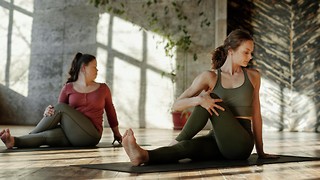From Cindies to Tokyo: Life expectancy, OAP fitness, and deep fried goodness
In her column this week, Anna Hollingsworth attempts to demystify Japan’s high life expectancy.

My first time was a bit of a shocker. I’d signed up for what seemed to be a normal, youthful institution; but after a thorough process of questioning and instructing (‘do I have any tattoos?’, ‘do I want evening access only or earlier as well?’, ‘it may be okay to keep your shoes on in England but not here’), I was greeted by a rather more aged clientele. My bank account a lot slimmer after encountering rather hefty joining fees, I was panic-stricken: could they cater for my more youthful, aerobic, even virile needs? But since that first time, my newly found Tokyo gym has taught me a lesson or two about OAP fitness in Japan.
Sounding like I need an emergency nebuliser on the crosstrainer or desperately chasing that elusive ab crack (very much in vain, I’m afraid), I’ve got nothing on my elder gym buddies, many of them on the better side of 70. Panting away on an exercise bike, ‘I Will Survive’ on my iPod sounding like an increasingly unlikely statement, I witness a grey-haired lady casually slipping from ‘destroyer of the universe’ to ‘wounded peacock’ or what have you in advanced yoga, and another doing a prolonged head-stand; my best friend now, a samurai-style clad gentleman way over 80, looks at my sorry excuse of a plank, wishing me ‘ganbatte’ – ‘do your best’, ‘good luck’ – and hitting the ab machine. Bet he has more than just one ab crack.
In retrospect, I shouldn’t have been surprised by the discovery of eternal youth at my local gym. Japan regularly tops life expectancy charts, with women expecting to hit 86.8 and men 80.5 years on average; what’s more, at least 75 of those years are estimated to be disability-free and healthy. For the UK, the key figures are 83.0 and 79.4 years respectively. Not that I feel closer to the grave than anyone else at the gym. Modern day alchemists trying to understand the Japanese secret to longevity turn to the diet more often than not – fish aplenty, some seaweed thrown in for good measure, vegetables at every meal, and sweet things in moderation. Can you really deny tucking into a katsu curry at Wagamama, thinking it must be the paragon of health? (spoiler: I’ve checked the nutritional values and it’s not. I wouldn’t recommend looking that up yourself if you still want to enjoy your katsu experience.)
Admitted, I was excited about the prospect of extending my life span over my three months of healthy eating in Tokyo, but a disillusionment much bigger than how unfit I’m compared with my fellow gym goers has been how apparently unhealthy the diet is. The staples of any meal – yes, that includes breakfast, lunch, and dinner – are white rice and noodles, the zero-nutrition nightmares of any nutritionist; we all know the ‘the browner the better’ mantra. Another favourite with most meals, miso soup, has been gaining the trendy status of a low-calorie health food in the West, but turns out it’s actually shockingly high in the dreaded sodium. Fruit comes in minuscule portions, and no wonder because of the sky-high prices. And then there’s the love of tempura, – deep-fried meat and vegetables – the practical non-existence of bread any other than super white (we’re talking ‘light porcelain’ in make-up terms here), and the omnipresence of all things breaded, like the meat eater’s favourite tonkatsu. As an example, the other night our dinner lady dished up tempura vegetables – the non-vegetarians were treated to seafood and chicken as well –, a mayo-pasta salad, rice, and, for the added health effect, a bowl of veggies with a hefty topping of salt.
Munching away on deep-fried goodness, I’ve been left contemplating the longevity mystery. True, fish is chosen over red meat as the primary meat, said to reduce risks of diseases like cancer; dairy products are minimal in quantity compared with a standard Western diet, and smaller plates are claimed to make diners feel fuller with smaller portion sizes. But at the same time the people in the Nuoro province of Sardinia or the Greek island of Ikaria are also renown for the longevity, all snacking on a Mediterranean diet heavy with cheese and yoghurt – I won’t be giving up my port and cheese just yet just to live longer. Another suggestion is that all the difference is made by the younger generations taking care of their elderly relatives instead of a bye-bye to Shady Pines. This is meant to guarantee stress-free living after years of high-pressure work. How it compensates for the stress endured in the work-hard-play-not-so-hard culture before then, I don’t know.
One thing the life expectancy secret is not due to, though, is a magic gene: Japanese people started celebrating increasingly bigger birthdays only after the Second World War. That’s good news for the non-genetically Japanese among us, at least.
With that as an encouragement, I’ll continue to try to discover the secret to eternal youth. Or maybe just try to master an even semi-stable headstand to increase my credibility at the gym
 News / ‘Out of the Ordinary’ festival takes over Cambridge 26 August 2025
News / ‘Out of the Ordinary’ festival takes over Cambridge 26 August 2025 News / Government pulls £277M in funding for Cambridge sewage works relocation25 August 2025
News / Government pulls £277M in funding for Cambridge sewage works relocation25 August 2025 News / Tompkins Table 2025: Trinity widens gap on Christ’s19 August 2025
News / Tompkins Table 2025: Trinity widens gap on Christ’s19 August 2025 Comment / Who could possibly want more exams?25 August 2025
Comment / Who could possibly want more exams?25 August 2025 News / News in Brief: Brain breakthroughs, bouldering, and the ‘broligarchy’24 August 2025
News / News in Brief: Brain breakthroughs, bouldering, and the ‘broligarchy’24 August 2025









